计划生育和二胎政策英文ppt
中国的计划生育政策演变(英文)共18页文档
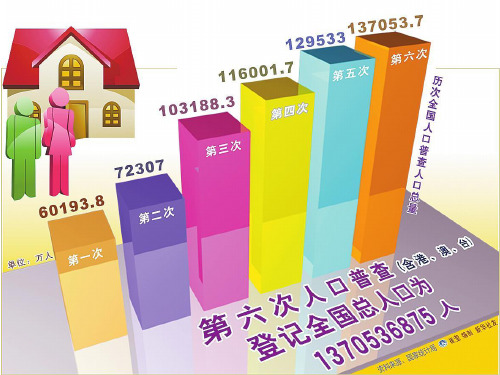
Gone, the slogans
In recent years, as the government advocates a people-first philosophy in governance, those slogans disappear quickly and some can only be found on photos.
Coming, the challenges
♂ an aging population
we can curb population growth counting on family planning policy, but we can not stop the trend that our nationals are becoming more and more elder. Some people worried that China will grow old before it grows wealthy. So some suggestions nowdays are also proposed that chinese family planning policy should be more slack to meet the challenge. This maybe need our government to take it seriously.
family planning policy
1970-1980 1980-1984
孩” 1991-至今
“晚、稀、少” “晚、稀、少”调整为“晚、一
现行计划生育政策(相对宽松)
晚:晚婚 late marriage 稀:生育间隔 4-year birth spacing 少:只生两个孩子 only two
二孩政策(two-child policy)
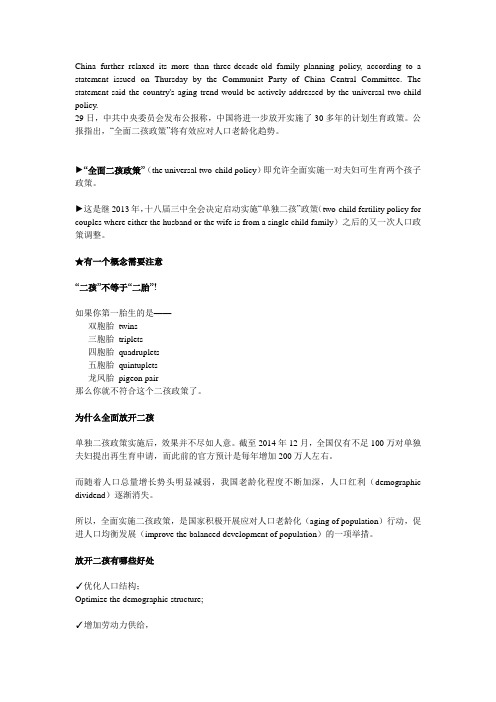
China further relaxed its more than three-decade-old family planning policy, according to a statement issued on Thursday by the Communist Party of China Central Committee. The statement said the country's aging trend would be actively addressed by the universal two-child policy.29日,中共中央委员会发布公报称,中国将进一步放开实施了30多年的计划生育政策。
公报指出,“全面二孩政策”将有效应对人口老龄化趋势。
►“全面二孩政策”(the universal two-child policy)即允许全面实施一对夫妇可生育两个孩子政策。
►这是继2013年,十八届三中全会决定启动实施“单独二孩”政策(two-child fertility policy for couples where either the husband or the wife is from a single child family)之后的又一次人口政策调整。
★有一个概念需要注意“二孩”不等于“二胎”!如果你第一胎生的是——双胞胎twins三胞胎triplets四胞胎quadruplets五胞胎quintuplets龙凤胎pigeon pair那么你就不符合这个二孩政策了。
为什么全面放开二孩单独二孩政策实施后,效果并不尽如人意。
截至2014年12月,全国仅有不足100万对单独夫妇提出再生育申请,而此前的官方预计是每年增加200万人左右。
而随着人口总量增长势头明显减弱,我国老龄化程度不断加深,人口红利(demographic dividend)逐渐消失。
计划生育英文版

Should China Allow her People to Have a Second Child?In the early 1970s, China started to carry out the one-child policy. At that time, the population in China was so large that it brought many problems to our society. We could not provide enough food and education for all the people, so the government needed to control its population. Everyone had to accept that we don’t allow one couple to have a second child. The policy on family planning is reasonable and necessary. Though it is a big challenge for the traditional opinion of “More children, more happiness”.In this way, the growth rate of population declined sharply, from 5.8 percent in 1970 to 2.24 percent in 1980, reducing the great stress on economic development. However, some people still fight against this policy, which are from both from personal and public point of view.As far as I know, there are many people who give birth to a second child, in spite of a heave fine. My aunt is one of them. Her first son is just 9 month younger than me, but she still got pregnant in 2006, and now she has a son and a young daughter. I was so curious that I asked her about it. She said that she really wanted a little daughter, and the fine was not that much. By the way, she comes from the countryside. In her hometown, it is very common to have two children or more. When I asked my cousin about his feelings of a new sister, he just shrugged. It seems that the past thirty years is not long enough to change the traditional view.In the public point, some people think that this policy goes against the human rights, and this may cause some bad results in the future. Actually, we have seen some of the negative effects. For example, the aged tendency. National Bureau of Statistics announced that China has entered an aging society since 1999. This means China has to take measures to solve this problem. In Europe and America, they faced this problem when their GDP had reach 2000 dollars. But in China, it was 1000 dollars. So people say that they will get old when they are rich, but we will get old before we are rich. Now we don’t have enough young labor force to feed these old people. We need more than one child to take care of their elderly people. Farmers need more children to help with the work. Maybe it’s time to allow people to have more children.To control birth has also caused other problems. But at that time, it was the best way to solve the society issue. Other countries also try this method to control birth. India, for example, calls on its young couples to have two children, a boy and a girl. However, people there don’t obey this policy, and the government doesn’t punish the people who have more than two children. So it is said that in 2050, India's population will exceed China, becoming the world's most populous country.In my opinion, the more progressive the society is, the less desire its people have to give birth to children. In the city, because of the life pressure, more young people are even thinking of not having children atall. I don’t think this will benefit the society. So I do hope the one-child policy will change very soon. People should be allowed to have more children. Only in this way can we solve the problem and make China become a powerful country.Source: /view/32644.html?wtp=tt/zh-cn/Wikipedia:%E9%A6%96%E9%A1%B5。
二胎政策英文解读
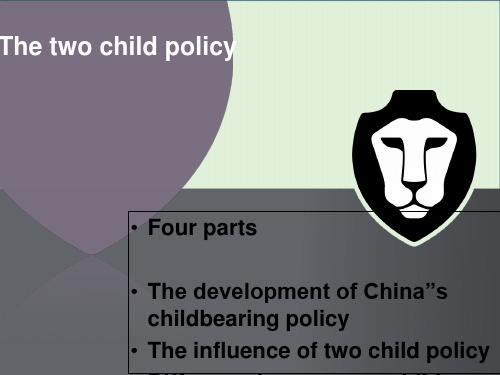
BPP LEARNING MEDIA
00 MO NT
H 000
0
Short-term effect
Short-term effect
Market’s demand and supply
Improve the quality of labor
Improve the wages in some sectors
BPP LEARNING MEDIA
Improve the size of workforce
• Before two-child policy,the prediction of China’s Ageing
BPP LEARNING MEDIA
Improve the size of workforce
•3、Two BPPLEARNINGMEDIA child policy fully liberalised
The policy shift and repeated〔1954 — 1959〕
• China”s first population census was conducted in 1953,the result of the cencus Results showed that the population is much higher than expected, matching with the limited resources and backward in our country, shook the government leaders.
人口与计划生育法英文介绍
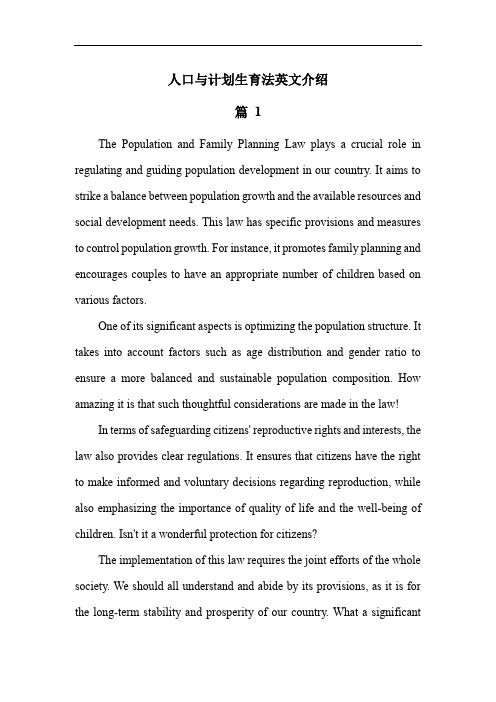
人口与计划生育法英文介绍篇1The Population and Family Planning Law plays a crucial role in regulating and guiding population development in our country. It aims to strike a balance between population growth and the available resources and social development needs. This law has specific provisions and measures to control population growth. For instance, it promotes family planning and encourages couples to have an appropriate number of children based on various factors.One of its significant aspects is optimizing the population structure. It takes into account factors such as age distribution and gender ratio to ensure a more balanced and sustainable population composition. How amazing it is that such thoughtful considerations are made in the law!In terms of safeguarding citizens' reproductive rights and interests, the law also provides clear regulations. It ensures that citizens have the right to make informed and voluntary decisions regarding reproduction, while also emphasizing the importance of quality of life and the well-being of children. Isn't it a wonderful protection for citizens?The implementation of this law requires the joint efforts of the whole society. We should all understand and abide by its provisions, as it is for the long-term stability and prosperity of our country. What a significantand far-reaching law it is!篇2The Population and Family Planning Law has played a crucial role in the development of our society! It has witnessed significant changes and improvements over the years.In the early stages, this law aimed to control population growth and balance the population structure. As time went on, it has been continuously adjusted and refined to adapt to the changing social and economic circumstances. For instance, in some areas, it has focused on improving the quality of the population and promoting balanced population development.The significance of this law is immense! It has had a positive impact on the rational allocation of resources. By controlling population growth, it has helped to ensure that resources such as food, education, and medical care are distributed more effectively. This has undoubtedly contributed to the stable and sustainable development of society and the economy.How could we imagine a society without such a law? It would likely lead to chaos and imbalance in resource distribution. The Population and Family Planning Law is not just a set of regulations; it is a guiding light that leads us towards a better future. Isn't it amazing how such a law can shape the destiny of a nation?In conclusion, the Population and Family Planning Law is an essential tool for maintaining social order and promoting the well-being of thepeople. We should continue to pay attention to its development and implementation to ensure its effectiveness in the long run.篇3Population and Family Planning Laws are crucial for the development and stability of nations. In some developed countries, advanced population policies have been implemented. For instance, countries like Sweden and Denmark have emphasized on providing comprehensive family support, including generous parental leave and high-quality child care services. This has not only encouraged couples to have children but also ensured the well-being of children and families. How wonderful is this approach?On the other hand, developing countries often face similar challenges. Take India and Brazil as examples. They struggle with issues such as rapid population growth, limited resources, and insufficient social welfare. Isn't it a huge burden for these countries?The differences and similarities among these laws are quite remarkable. In developed countries, the focus is more on maintaining a balanced population structure and improving the quality of life. But in developing countries, the priority is often to control population growth to match the available resources. Isn't this a significant contrast?In conclusion, understanding and comparing the characteristics of Population and Family Planning Laws in different countries can provide valuable insights for formulating more effective policies. Don't you thinkso?篇4The Population and Family Planning Law has been of great significance in regulating population growth and promoting balanced development. However, during its implementation, various problems have emerged. For instance, in some remote areas, the lack of adequate medical resources and educational propaganda has made it difficult to ensure the effective execution of the law. People's traditional concepts and cultural factors have also posed obstacles to the implementation of the policy. How to solve these problems? One of the measures is to increase investment in medical infrastructure and professional training in these areas. This can improve the quality and accessibility of family planning services. Moreover, strengthening publicity and education through various channels, such as community activities and online platforms, can enhance people's understanding and acceptance of the law. Another important aspect is to formulate more flexible and targeted policies based on local actual conditions. Isn't it necessary to take into account the differences between regions and groups? Of course! Only by constantly adjusting and improving can the Population and Family Planning Law better meet the needs of social development and achieve its intended goals. Isn't that amazing?篇5The Population and Family Planning Law has been a significant aspect of social policy, exerting a profound influence on the trajectory of population development. This law is not just a set of regulations; it's a powerful tool shaping the future of our society!Consider the potential changes in population size. Under the sustained effect of this law, we might witness a controlled growth rate. Isn't it fascinating to think that this could lead to a more balanced distribution of resources and a reduced burden on social infrastructure?The age structure is another crucial aspect. We could expect a gradual shift towards an aging population. But what does this mean for our healthcare systems and social security? Will we be well-prepared to meet the needs of an older demographic?It's not all straightforward, though. There could be challenges along the way. For instance, how will a smaller working-age population impact economic productivity? How will we ensure the well-being of the elderly in a changing age structure?In conclusion, the Population and Family Planning Law holds the key to shaping the future of our population. It's a complex and dynamic issue that demands our continuous attention and thoughtful adaptation. How we navigate these changes will determine the quality of life for future generations. Isn't that a responsibility we all share?。
中国计划生育政策 英文介绍

10/11/2020
2002 POPULATION and FAMILY PLANNING LAW
Article 23 The State rewards couples who practise family planning.
POPULATION DENSITY
10/11/2020
10/11/2020
DEMOGRAPHIC DATA 2006
Population: 1,313,973,713
Age structure: 0-14: 21% 15-64: 71% 65+: 8%
Population growth rate: 0.6% Birth rate: 13‰ Death rate: 7‰ Sex ratio: under 15 years: 118 male/100 female
2 Longer spacing between births – couples were encouraged to allow at least a four-year gap after the first child before having another baby.
3 Fewer children – it was suggested that urban families should be limited to two children, and rural families to three children.
10/11/2020
2002 POPULATION and FAMILY PLANNING LAW
全面二胎政策英文学习
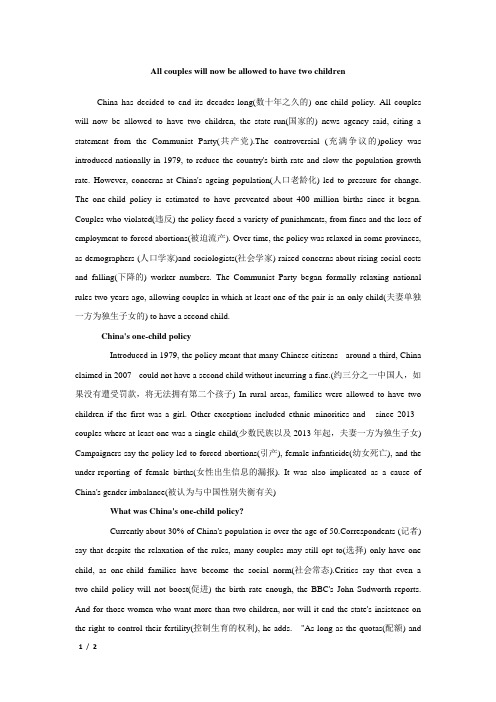
All couples will now be allowed to have two childrenChina has decided to end its decades-long(数十年之久的) one-child policy. All couples will now be allowed to have two children, the state-run(国家的) news agency said, citing a statement from the Communist Party(共产党).The controversial (充满争议的)policy was introduced nationally in 1979, to reduce the country's birth rate and slow the population growth rate.However, concerns at China's ageing population(人口老龄化) led to pressure for change.The one-child policy is estimated to have prevented about 400 million births since it began.Couples who violated(违反) the policy faced a variety of punishments, from fines and the loss of employment to forced abortions(被迫流产).Over time, the policy was relaxed in some provinces, as demographers (人口学家)and sociologists(社会学家) raised concerns about rising social costs and falling(下降的) worker numbers.The Communist Party began formally relaxing national rules two years ago, allowing couples in which at least one of the pair is an only child(夫妻单独一方为独生子女的) to have a second child.China's one-child policyIntroduced in 1979, the policy meant that many Chinese citizens - around a third, China claimed in 2007 - could not have a second child without incurring a fine.(约三分之一中国人,如果没有遭受罚款,将无法拥有第二个孩子)In rural areas, families were allowed to have two children if the first was a girl.Other exceptions included ethnic minorities and - since 2013 - couples where at least one was a single child(少数民族以及2013年起,夫妻一方为独生子女)Campaigners say the policy led to forced abortions(引产), female infanticide(幼女死亡), and the under-reporting of female births(女性出生信息的漏报). It was also implicated as a cause of China's gender imbalance(被认为与中国性别失衡有关)What was China's one-child policy?Currently about 30% of China's population is over the age of 50.Correspondents (记者) say that despite the relaxation of the rules, many couples may still opt to(选择) only have one child, as one-child families have become the social norm(社会常态).Critics say that even a two-child policy will not boost(促进) the birth rate enough, the BBC's John Sudworth reports.And for those women who want more than two children, nor will it end the state's insistence on the right to control their fertility(控制生育的权利), he adds."As long as the quotas(配额) andsystem of surveillance (监控)remains, women still do not enjoy reproductive rights," Maya Wang of Human Rights Watch told AFP. The announcement comes on the final day of a summit of the Chinese Communist Party's policy-making Central Committee, known as the fifth plenum(五中全会).The party is also set to announce growth targets and its next five year plan(五年计划).。
关于生二胎的英文ppt
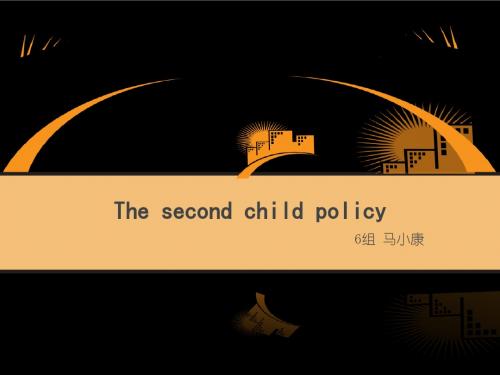
6组 马小康
Contents
目录
Review the one-child policy
01
02 03 04
2015-4-27
The necessity of changing the policy
Introduce the second child policy
My opinion
In fact,there are more choice for young couples, but also a necessity for some cities. The relax to China´s family planning policy is a positive response to the current population structure.But as long as other supporting policies don’t change, rearing children remains an expensive undertaking in China,which may prevent qualified couples from having a second child. And, as everywhere in the world, we all want the very best for our children.So here we call for more complement policies to help to build ideal-sized family in the future
My opinion
Review the one-child policy
计划生育 英文
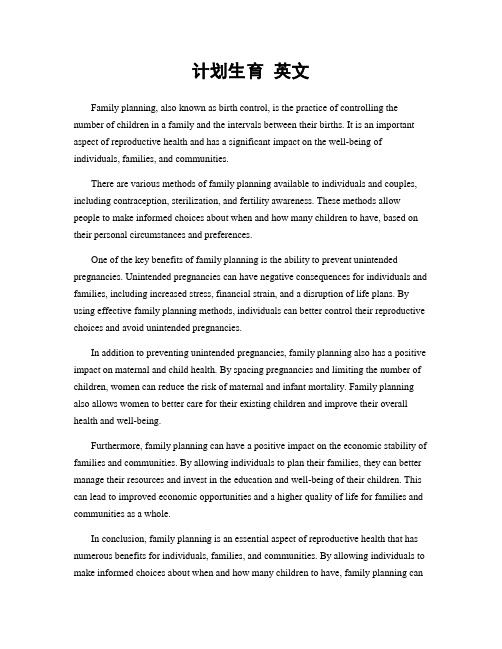
计划生育英文Family planning, also known as birth control, is the practice of controlling the number of children in a family and the intervals between their births. It is an important aspect of reproductive health and has a significant impact on the well-being of individuals, families, and communities.There are various methods of family planning available to individuals and couples, including contraception, sterilization, and fertility awareness. These methods allow people to make informed choices about when and how many children to have, based on their personal circumstances and preferences.One of the key benefits of family planning is the ability to prevent unintended pregnancies. Unintended pregnancies can have negative consequences for individuals and families, including increased stress, financial strain, and a disruption of life plans. By using effective family planning methods, individuals can better control their reproductive choices and avoid unintended pregnancies.In addition to preventing unintended pregnancies, family planning also has a positive impact on maternal and child health. By spacing pregnancies and limiting the number of children, women can reduce the risk of maternal and infant mortality. Family planning also allows women to better care for their existing children and improve their overall health and well-being.Furthermore, family planning can have a positive impact on the economic stability of families and communities. By allowing individuals to plan their families, they can better manage their resources and invest in the education and well-being of their children. This can lead to improved economic opportunities and a higher quality of life for families and communities as a whole.In conclusion, family planning is an essential aspect of reproductive health that has numerous benefits for individuals, families, and communities. By allowing individuals to make informed choices about when and how many children to have, family planning canhelp prevent unintended pregnancies, improve maternal and child health, and promote economic stability. It is important for individuals and societies to support and promote access to family planning services and information, in order to ensure that everyone has the opportunity to make informed decisions about their reproductive health.。
- 1、下载文档前请自行甄别文档内容的完整性,平台不提供额外的编辑、内容补充、找答案等附加服务。
- 2、"仅部分预览"的文档,不可在线预览部分如存在完整性等问题,可反馈申请退款(可完整预览的文档不适用该条件!)。
- 3、如文档侵犯您的权益,请联系客服反馈,我们会尽快为您处理(人工客服工作时间:9:00-18:30)。
Population control
The rapid population growth rate has obviously dropped since 1970s when the Chinese began to practice family planning.
The Family Planning Policy also lightens the social and national burden because of the large amount population,and the Family Planning Policy can make each person share more material and spirit resources.
1 .Population control
2.Quality of life for women
3.Health-care improvements
China has the largest population in the world, more than 1.3 billion, which is 20% of the world population.
The two-child policy
At the end of 2014, China had a population of 1.37 billion people. A total of 800 million of them are employed. But that job market population is expected to drop by 2050. With the two-child policy, an increase in births will ease the labor shortage, starting in 20 years.
Historical Background
“
how to solve it?
Historical Background
LOREM IPSUM DOLOR
LOREM IPSUM DOLOR LOREM IPSUM DOLOR LOREM IPSUM DO
The good effects on The Family Planning
Bad Effects On The Family Planning
4-2-1ult for a single child to support a family,especially the “4-2-1 Family”.
Rural labor and Protection of ethnic minorities
The statement said the change is meant to balance population development. It said the move also attempts to stop a declining birth rate and strengthen the country's work force.
Increasing labor supply 增加劳动力供 给
Every coin has two sides Everyone has their own opinion We should make a decision by the realities
To be or not to be, this is a question.
Health-care improvements
contraception and prenatal classes.
The average Chinese household expends fewer
resources, both in terms of time and money on children.That makes parents can save some time and money for their own.
Family planning hold a part as the whole, do not take care of the rural labor force and minority protection.
Aging of population
specific figures show aging and serious influence to social and economic.
Quality of life for women
in Chinese households. However, the one-child policy's
limit on the number of children has prompted parents of women to start investing money in their well-being. As a result of being an only child, women have increased opportunity to receive an education, and support to get better jobs.
编辑文字
单击此处添加您的编辑文字 标题,您的团队名称,您的 公司名称
Historical Background Second ---Infant mortality rate declined from 22.7/100 in 1949 to 5.3/100 in 1981,and life expectancy dramatically increased from around 35 years in 1945.
1
Optimizing the demographic structure 优化 人口结构
2
3 Easing pressure from the aging population 缓解 人口老龄化压力
4
Helping improve the health of the economy有利 于促进经济持续 健康发展
It is reported that the focus of China on population
. planning helps provide a better health service for
women and a reduction in the risks of death. At family planning offices, women can receive free
Company or person name
Family Planning &
Two-Child Policy
1
Historical Background
2 Good effect
3
4
Bad effect
The two-child policy
Historical Background First ---In the initial period of China,we need more people to develop our countries.
Yes
1 Emotional well-being
reasons
2 The pension problem
3
The traditional view
No
1
reasons
Growing burden on households
2 More time and energy
3
Why the government readjusted the family planning policy?
The one-child policy has played a major role in
improving the quality of life for women in China. For thousands of years, girls have held a lower status
